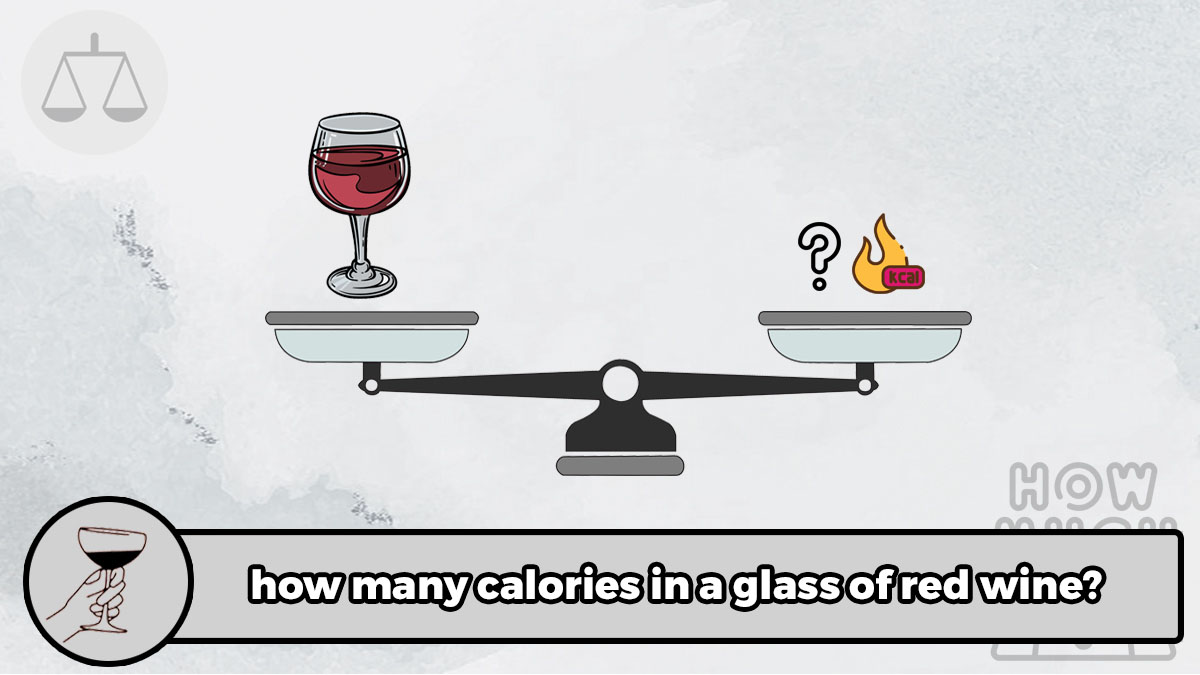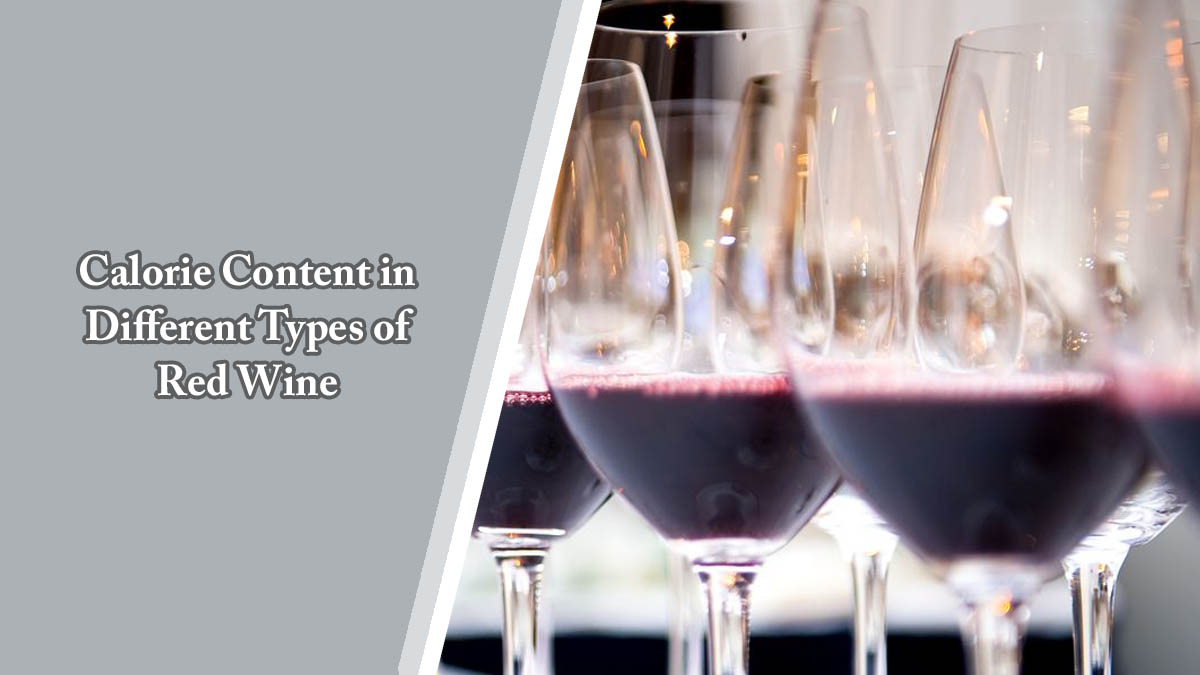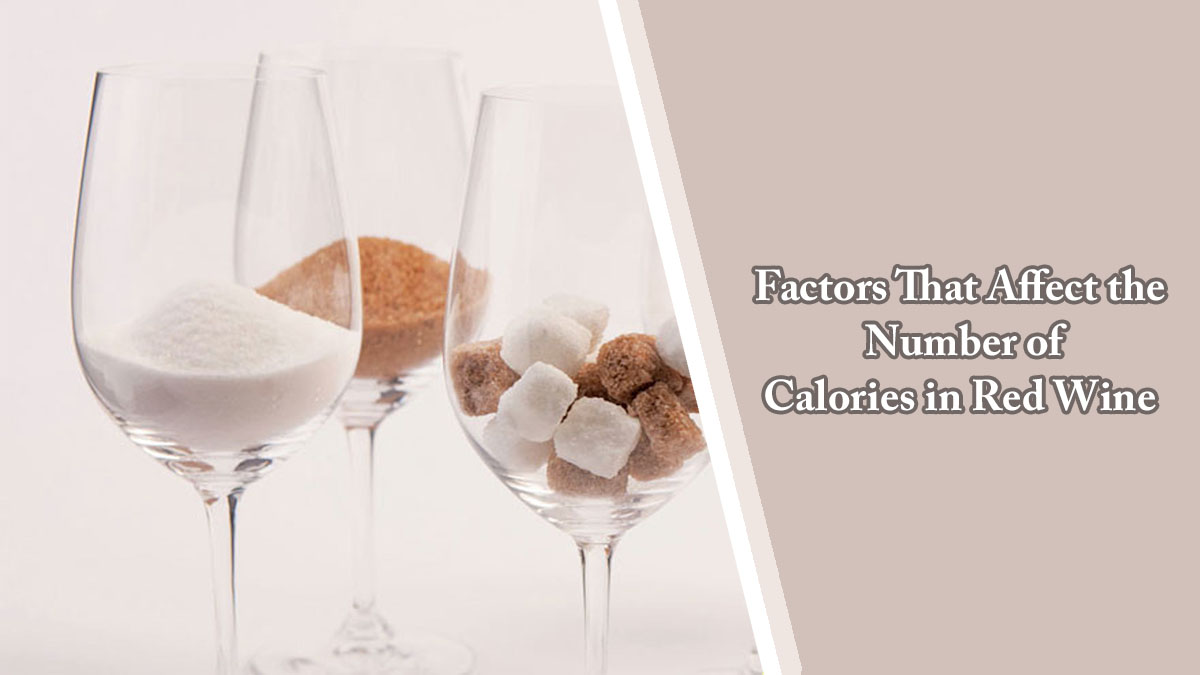How Many Calories in a Glass of Red Wine?
Have you ever wondered “How many calories in a glass of red wine?” Whether you’re looking to indulge responsibly or simply curious about the nutritional value of your favorite beverage, understanding what’s in a glass of your preferred vino can be helpful. While drinking alcohol is not recommended for individuals watching their weight, there are still smart ways to perform ‘responsible sipping’, if that is part of your lifestyle.
After all – variety is the spice of life! This blog post will delve into the caloric content in your favorite varietal, explain why calorie counts vary for different brands and styles of red wines, plus share some tips on how to drink more healthfully overall. So get ready – let’s explore those calories in red wine!
How Many Calories in a Glass of Red Wine?
Calories in red wine can vary widely depending on the type, brand, and vintage as well as serving size. Generally speaking though, one 5-ounce glass of red wine contains 125 calories (means 50 calories per oz). While this may not seem like a lot, it can add up quickly if you’re drinking more than one glass in an evening.
Additionally, lower-calorie wines tend to be lower in alcohol content so if you’re looking for the lowest-calorie option, it may be best to opt for those with lower alcohol levels such as Pinot Noir. If you’re opting for dessert wines though – like Port or Sherry – be aware that they do contain significantly more calories per serving due to their higher sugar content.
Understanding the caloric content of your favorite varietal is beneficial when trying to keep an eye on your lifestyle choices and overall health. So while there are no hard and fast rules when it comes to having a healthy relationship with alcohol, knowing how many calories are in each glass of red wine can help make sure you’re sipping responsibly!
Calorie Content in Different Types of Red Wine
Above, we’ve given you an average for all red wines. However, to find out how many calories are in specific wines like Cab Sauv or Merlot in a glass of wine, read on. In the following, we will discuss the calorie content of the top 8 most popular kinds of red wine.
1. Cabernet Sauvignon: Cabernet Sauvignon is a well-known red wine with high alcohol and tannin content. This type of wine contains around 122 calories per glass (5 fl. oz), depending on the brand and origin. Dry Cabernet Sauvignon has fewer calories than sweet Cabernet Sauvignon.
2. Merlot: Merlot is another popular red wine that is softer and smoother than Cabernet Sauvignon. This type of wine contains around 122 calories per glass (5 fl. oz), depending on the brand and age. Young Merlots have fewer calories than aged Merlots.
3. Pinot Noir: Pinot Noir is a lighter red wine with low tannin content. This type of wine contains around 120 calories per glass (5 fl. oz), depending on their location and winemaking process. French Pinot Noir has fewer calories than American Pinot Noir.
4. Malbec: Malbec is a red wine with medium acidity and tannin content. This type of wine contains around 135 calories per glass (5 fl. oz), depending on their region and age. Young Malbecs have fewer calories than aged Malbecs.
5. Syrah (Shiraz): Syrah or Shiraz is a complex red wine with high tannin content. This type of wine contains around 122 calories per glass (5 fl. oz), depending on its origin and quality. Australian Shiraz has fewer calories than American Syrah.
6. Grenache (Garnacha): Grenache or Garnacha is a red wine with moderate tannin content and high alcohol content. This type of wine contains around 122 calories per glass (5 fl. oz), depending on its location and vintage. Young Grenache has fewer calories than aged Grenache.
7. Zinfandel: Zinfandel is a red wine with high alcohol content and robust fruit flavors. This type of wine contains around 130 calories per glass (5 fl. oz), depending on the region and winemaking process. Dry Zinfandel has fewer calories than sweet Zinfandel.
8. Barolo: Barolo is a full-bodied and high-tannin red wine made in northern Italy. This type of wine contains around 121 calories per glass (5 fl. oz), depending on the vintage and winemaking process. Young Barolo has fewer calories than aged Barolo.
Red wines vary in their calorie content, depending on their grape varietals, location, vintage, and winemaking process. In general, dry red wines have fewer calories than sweet red wines.
Factors That Affect the Number of Calories in Red Wine
Most people believe that red wine has the same number of calories regardless of the brand, but that is not true. There are a few factors that affect the calorie count in red wine, and this article will explore them in detail.
Alcohol Content
The alcohol content in any kind of liquor directly affects the number of calories in it. Red wine has an alcohol content ranging from 12% to 15%. As a rule of thumb, the higher the alcohol content, the more calories. Therefore, if you’re looking to reduce your calorie intake, it is recommended to go for a lower alcohol content, such as Pinot Noir, rather than a Cabernet Sauvignon.
Why does alcohol concentration affect calories?
The alcohol content in any kind of liquor directly impacts the number of calories it contains. As alcohol is composed of seven calories per gram, the higher the alcohol content in red wine, the more calories it will have. Moreover, alcohol is a natural diuretic and a depressant that can increase appetite and slow down your digestion process, leading to higher calorie intake. For these reasons, it is important to pay attention to the alcohol content of red wines when monitoring their calorie intake. Additionally, dry red wines tend to be lower in calories than sweet wines due to their lower sugar content.
Serving Size
The number of calories in red wine also depends on the size of your glass. If you pour yourself a larger glass, you will consume more calories. So, it’s essential to be mindful of the serving size of wine that you pour yourself. The industry standard for a serving size of wine is a 5-ounce glass. Also, consider the frequency of the drink. Drinking occasionally, one small glass of wine will not affect your health substantially.
Know more: How Many Glasses of Wine in a Bottle?
Sugar Content
The sugar content in red wine is another factor that determines the number of calories in it. Sweet wines, such as Zinfandel or Port, have more sugar than dry wines, such as Pinot Noir, Merlot, or Cabernet Sauvignon. Wines with a high sugar content also mean more calories. So, if you’re watching your calorie intake, you should avoid sweet red wines.
Age of the Wine
The age of the wine also affects its calorie count. Young red wines have fewer calories than older ones. The aging process in wines allows the sugar content to ferment and convert to alcohol, ultimately reducing the calories. So, if you’re looking to consume fewer calories, it would be best to go for younger red wines.
Winemaking Process
The winemaking process also affects the calorie count in red wine. During the fermentation process, grape juice is converted into wine via yeast. The yeast consumes the sugar, ultimately producing alcohol. The more alcohol that is produced during the fermentation process, the more calories the wine has. Some winemakers also add sugar to the process to increase the alcohol content, also adding more calories to the wine.
Now that we have explored the factors that affect the number of calories in red wine, it’s essential to note that moderation is key. It’s okay to indulge in a glass or two whenever you feel like it, but being mindful of the serving size, sugar, and alcohol content can help you maintain a healthy lifestyle while still enjoying your favorite wine.
Tips for Enjoying Red Wine While Limiting Calories
Many people find it challenging to balance their love of wine with their desire to maintain a healthy lifestyle. But, it is possible to enjoy red wine while limiting calories. In this article, we will discuss several tips for drinking red wine without worrying about calories.
1. Choose Wines with Fewer Calories: When it comes to wines, not all options are created equal. Some types of red wine, such as Merlot or Pinot Noir, have fewer calories than other red wines. Dry red wines generally have lower calorie content than sweet and fruity wines. So, if you’re watching your calorie intake, opt for a dry red wine.
2. Practice Moderation: Moderation is key to enjoying red wine without the guilt of consuming too many calories. Experts believe that consuming one glass of red wine per day can be beneficial for your health. It is important to remember that drinking too much red wine can lead to weight gain, so it’s essential to practice moderation.
3. Watch Your Portion Sizes: The amount of wine in one glass can vary, and the amount you pour affects the number of calories you consume. One serving of wine is only five ounces, which is smaller than you may think. So, when pouring your glass of red wine, make sure to measure it accurately. You can also use a smaller glass to make the amount of wine you pour seem more substantial.
4. Pair Wine with Healthy Foods: To limit your calorie intake, it’s essential to choose healthy foods to pair with your wine. Try to choose options that are high in fiber and protein but low in fat and sugar. Some healthy foods that go well with red wine include dark chocolate, grilled vegetables, lean meats, and nuts.
5. Workout Regularly: Exercising regularly is essential for maintaining a healthy lifestyle. If you’re concerned about consuming too many calories from red wine, exercise can help you burn them off. Combining a healthy diet and regular exercise is essential to help you balance your calorie intake and enjoy red wine.
You can enjoy your love of red wine while limiting calorie intake by following these simple tips. Choose wines with fewer calories, practice moderation, watch your portion sizes, pair wine with healthy foods, and work out regularly. Keep in mind that moderation is key to balancing a healthy lifestyle, and it’s essential to pair your love of wine with smart lifestyle choices.
Recommended Serving Sizes of Wine to Help Manage Your Caloric Intake
If you’re watching your weight or tracking your caloric intake, knowing the recommended serving sizes of wine can help you make informed choices while still enjoying your favorite beverage. Let’s explore some guidelines for proper wine serving sizes and how they can help you maintain a healthy lifestyle.
1. Understanding Standard Serving Sizes
A standard serving of wine is five ounces, which typically provides about 100-120 calories depending on the type of wine. Red wines tend to be slightly higher in calories than white wines or rosés due to their higher alcohol content. A six-ounce pour of wine can add an extra 20-30 calories per glass, which can quickly add up over an evening of drinking. It’s important to remember that wine glasses are often much larger than five or six ounces, especially at restaurants or bars. To combat this, consider purchasing a set of smaller wine glasses or dividing one bottle of wine into four to five servings to better control your intake.
2. Choosing Lower-Calorie Wine Options
If you’re looking to reduce your caloric intake while still enjoying a glass of wine, choosing lower-calorie options can be a great place to start. Dry wines like Sauvignon Blanc, Pinot Noir, and Cabernet Sauvignon tend to be lower in calories than sweet dessert wines or fortified wines like Port. Opting for a wine with a lower alcohol content, such as a Moscato d’Asti or a German Riesling, can also reduce your calorie intake while still enjoying a glass of wine.
3. Pairing Wine with Food
Wine and food pairing is an art form, but it can also help you manage your caloric intake. Eating a meal before having a glass of wine can help fill you up and reduce your desire to drink more than you should. Pairing your wine with protein-rich foods like grilled chicken or fish can also help mitigate the effects of alcohol on your body. Foods high in fat or sugar can slow down the absorption of alcohol, leading you to drink more than you intended. Pairing wine with a healthy and flavorful meal can help you enjoy your favorite beverage in moderation.
4. Moderation is Key
One of the most important things to remember about consuming wine or any alcoholic beverage is that moderation is key. The Dietary Guidelines for Americans recommend consuming no more than one drink per day for women and two drinks per day for men. Overconsumption of alcohol can lead to a variety of health problems, including liver disease, high blood pressure, and obesity. If you’re having difficulty sticking to moderate drinking guidelines, consider seeking help from a medical professional.
Keeping track of your caloric intake can be daunting, especially when trying to incorporate your favorite indulgences like wine. However, knowing the recommended serving sizes of wine and choosing lower-calorie options can greatly aid in managing your caloric intake. Remember to pair your wine with a healthy meal and practice moderation to keep your body and mind in good shape. With these guidelines in mind, you can continue to enjoy a glass of wine without sacrificing your health or lifestyle goals.
Tips for Choosing Low-Calorie Wines
Although the calories in a single glass of wine may not seem like much, it can have a significant impact on your overall caloric intake if you consume it regularly. If you are diabetic or watching your weight, you may want to avoid consuming wine with high-calorie content. But worry not, now, we will discuss some effective tips that can help you choose low-calorie wines without compromising on the taste.
1. Choose Wines with Low Alcohol Content
Wines with low alcohol content tend to have fewer calories. Alcohol contains almost 7 calories per gram, adding up very quickly in drinks. Therefore, it’s best to choose wines with less alcohol content. For instance, a wine with 12% alcohol content will have fewer calories than one with 14%. Notably, keep in mind that the best-tasting wines will have around 12-14% alcohol content.
2. Opt for Light Wines
There are popular wines such as Moscato, Riesling, and Gewurztraminer, which are light and low in calories than other red or white wines. These wines contain less alcohol, less sugar, and fewer calories, making them perfect for people watching their weight. Therefore, when choosing a wine, consider a light wine, which will be better for your body.
3. Drink Dry Wines
The sweetness of the wine comes from the natural sugar content in the grapes. A sweet taste is generally a sign of high sugar levels and hence more calories. However, dry wine has less natural sugar content since most of the sugar is fermented during the winemaking process. Thus, dry wines tend to have fewer calories than sweet wines.
4. Check Caloric Content and Nutritional Information
Reading the label can be essential when you are purchasing a bottle of wine. Check the caloric content and nutritional label of the wine before you indulge. Most wines have the label or the brand’s website where you will find detailed information about the wine’s caloric and nutritional value. Do some research to get an idea of what you are consuming.
5. Drink in Moderation
No matter the type of wine you choose, it’s crucial to consume it in moderation. Drinking excessively can lead to a lot more than just adding calories to your body. It can lead to dehydration, hangovers, and even liver damage. Therefore, it’s vital to consume alcohol in moderation to avoid any adverse effects.
Enjoying a glass of wine need not be against your weight loss goals or calorie-controlled diets. Many low-calorie wines are available on the market to work with your goals. To choose the right wine, opt for low alcohol content, light wines, and dry wines, and read the nutritional information.
FAQs
What types of wine contain the most calories?
When it comes to calories in wine, the type and size of the pour can make a big difference. Red wines tend to have higher calorie counts than whites. Generally speaking, a five-ounce glass of red wine contains around 125 calories, while a five-ounce glass of white wine contains around 100 calories.
The calorie count will depend on the specific type of red or white wine you choose. For instance, dry wines such as Cabernet Sauvignon and Chardonnay will generally contain fewer calories than sweet wines such as Zinfandel and Riesling. Moreover, sparkling wines such as Champagne and Prosecco are some of the highest calorie-containing varieties due to their sugar content. A single five-ounce glass of sparkling wine may contain up to 160 calories!
In short, if you’re looking for an alcoholic beverage that is low in calories, dry whites are your best bet; however, if you’re looking for something sweeter with more punch, opt for a lower-calorie sparkling variety like champagne or prosecco.
Are wines low in carbs and sugar?
Most wines contain a small number of carbohydrates and sugar. Sparkling wines, such as Champagne and Prosecco, tend to have the highest levels of both due to their production methods. On average, a five-ounce serving of sparkling wine contains around three grams of carbohydrates and 1.5 grams of sugar. Non-sparkling white wines contain about one gram of sugar per glass, while red wines are generally sugar-free.
When it comes to carbs, reds tend to be on the lower side with an average of one gram per five-ounce serving. Whites typically contain two or three grams per glass, with sweeter varieties providing slightly more. To put these numbers into perspective, most beers contain around 13 grams of carbs per 12-ounce pour while many light beer varieties offer just four grams or less.
All in all, if you’re looking for an alcoholic beverage that is low in carbs and sugar, dry white wine is your best bet; however, keep in mind that consuming alcohol in excess can still have negative health effects regardless of its carb and sugar content. Therefore, it’s important to drink responsibly and enjoy your wine in moderation.
How many glasses of red wine can I drink safely per week?
The answer to this question varies depending on the individual and their overall health. Generally speaking, moderate alcohol consumption is defined as no more than one drink per day for women and two drinks per day for men. According to the American Heart Association, moderate drinking can offer some health benefits, such as reduced risk of heart disease. However, it’s important to note that any amount of alcohol consumption carries potential risks and should be consumed responsibly.
When it comes to red wine, in particular, one five-ounce glass of dry red is equivalent to one drink. Therefore, if you are a woman following the recommended guidelines for moderate drinking you can safely have up to seven glasses of red wine per week (one drink per day). For men following these guidelines, the maximum recommended amount would be 14 glasses of red wine per week (two drinks per day).
It’s also important to keep in mind that there are numerous factors that can affect how much alcohol you can safely consume on a weekly basis. These include age, body weight/height/build, medical history, and family or personal history with addiction or alcoholism. Therefore, it is best to discuss your drinking habits with your doctor if you have any concerns about your alcohol consumption.
Which type of grapes are used to make a specific type of red wine?
Red wines vary greatly in taste and complexity based on the type of grape used to make them. The most commonly used grape varieties for red wine include Cabernet Sauvignon, Merlot, Pinot Noir, Syrah/Shiraz, Zinfandel, Malbec, and Sangiovese.
How much alcohol does a glass of red wine contain compared with other alcoholic drinks such as beer or spirits?
A five-ounce serving of red wine contains on average 12-13% alcohol by volume (ABV) while most beer varieties contain between 4-7%. Spirits, such as vodka and whiskey, tend to have the highest ABV at around 40%. This means that to consume the same amount of alcohol, you would need to drink around three times as much red wine as beer and more than triple the amount of spirits. Generally speaking, a single standard serving size of any type of alcoholic beverage is considered to be one drink.
When it comes to calories, there is a notable difference in the number of calories per serving between different types of alcoholic beverages. One five-ounce glass of dry red wine contains approximately 125 calories while the same size pour of lager beer has about 153 calories. Spirits are typically lower in calorie content per ounce than both beers and wines due to their higher ABV; however, mixers used with spirits will increase the overall calorie count. For example, one shot (1.5 ounces) of vodka mixed with cola adds about 165 calories compared to only 97 for a glass of non-sparkling white wine without any mixer.
Ultimately, the answer to the question “How many calories in a glass of red wine?” is 125. However, it is important to remember that this number may vary slightly depending on the type of grape and the fermentation process used. Additionally, keep in mind that consuming alcohol in excess can still have negative health effects regardless of its carb or calorie content. Therefore, it’s best to enjoy your glass of red wine responsibly and in moderation.
Conclusion
Ultimately, the answer to the question “How many calories in a glass of red wine?” is 125. However, it is important to remember that this number may vary slightly depending on the type of grape and the fermentation process used. Additionally, keep in mind that consuming alcohol in excess can still have negative health effects regardless of its carb or calorie content. Therefore, it’s best to enjoy your glass of red wine responsibly and in moderation.
By establishing mindful habits and proper portion control, it’s possible for red wine lovers to enjoy the occasional glass without having to worry about health consequences.
Thanks for taking the time to read this post. We hope that you now understand how many calories are in a glass of red wine as well as why drinking responsibly is beneficial for our health. It’s wonderful that you can learn more about how to maintain your caloric balance while enjoying the delights of wine without going over your daily recommended intake. Visit our Website for more interesting posts.

I am Thomas Delange, CEO of McMahon’s Public House bar. I have a passion for restaurants and cooking & wines, and I love to spend my free time experimenting in the kitchen. I’ve worked hard to make McMahon’s one of the most successful bars in the city. When I’m not working, I enjoy spending time with my friends and family.




